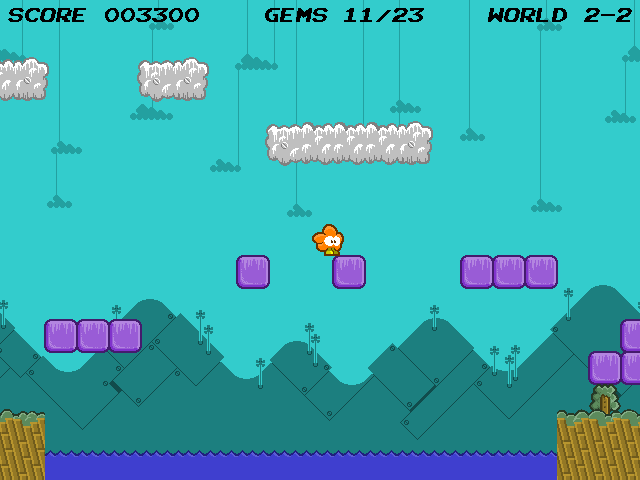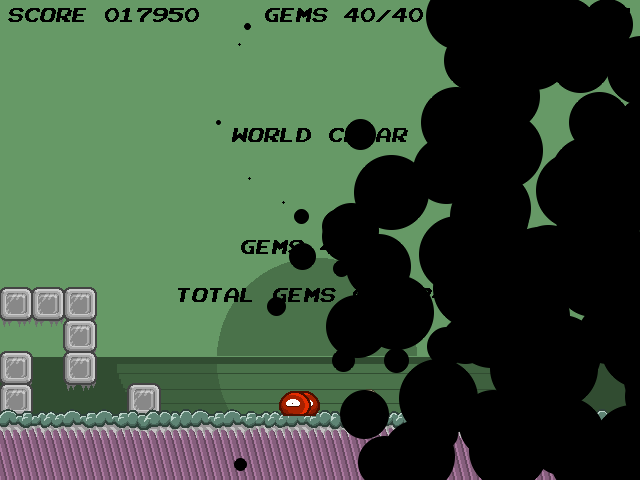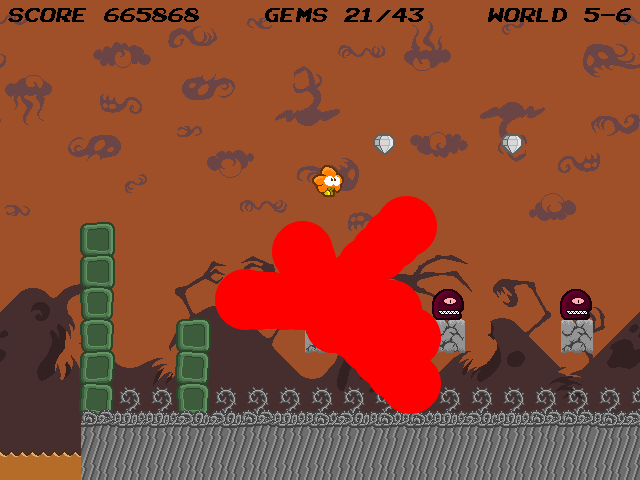Original Freeware Version || Steam Page
Eversion is definitely more well-known than most of the games covered here on Indie Overlook and it deserves the relative fame it has earned. It’s fairly safe to say that this deceptively cute platformer takes some inspiration from the infamous first stage of Monster Party on the NES, but Eversion has in turn gone on to become both a direct and an indirect inspiration for other indie games. It shows its age in spots, has its share of rough edges, and isn’t as novel now compared to when it first released, but it’s still certainly worth taking a look at both for its own merits and for its historical value in the fast-moving world of indie games.
At its heart, Eversion is a rather standard and fairly short platformer with a single, exceptionally well-executed twist. Zee Tee, the colorful flower-like protagonist, jumps on top of enemies and collects gems on his way to the goal flag at the end of each stage, but he also has one other ability – the power of eversion. Pressing the ‘Evert’ button initially seems to do absolutely nothing and you can indeed make it through the entire first stage without pressing this button at all, but you’ll inevitably hit a dead end in the second stage in the form of a seemingly impassable gap. This is where that Evert button comes into play as pressing this button in the right locations will change the world and when the world changes, so to do the rules.

Before we go any deeper into the inner workings of Eversion, I want to take this moment to look at where it falls in history. Eversion has been cited as a source of inspiration for some developers, but it’s hard to tell exactly how much influence it had on the industry. The original freeware version came out in late 2008, a time when indie games were still nowhere near as common as they are today, which meant that news of its release was picked up by a good number of the more popular indie game sites out there and, in turn, there was at least a decent chance that anyone already following indie game news at that time either played Eversion or at least became aware of it. Games with dimension-shifting mechanics definitely became more common in the years following Eversion’s release, and several developers have even directly cited it as one of their sources of inspiration, but on the other hand indie games in general rapidly rose in both popularity and quantity around 2010 and several of the games similar to it may very well have simply been inspired by Eversion’s own sources of inspiration.
Pinning down just what inspired the creation of Eversion is easier than trying to sort out which games were inspired by it. The original release was actually a contest entry for the Commonplace Book Competition held by TIGSource from October 17 to November 27 in 2008. The goal of this competition was to make a game based around story ideas found in H.P. Lovecraft’s commonplace book and the quote which Eversion is based off of is “sounds, possibly musical – heard in the night from other worlds or realms of being”. This quote is certainly worked into the gameplay mechanics rather well as the special locations where the Evert button functions are marked by a change in music along with a slight change in color (and sometimes a radar-like ping if you press the button near one). But this quote is almost certainly not the only source of inspiration at play here. Eternal Darkness is a rather well-known game with a strong Lovecraft influence and the famous tricks and changes brought about by its sanity system probably were at least a minor form of inspiration here. However, the first stage of Monster Party on the NES, where a seemingly cheerful stage suddenly becomes filled with blood and skulls, an astonishingly graphic sight for the otherwise generally kid-friendly and heavily censored NES, seems to be the most obvious video game influence for Eversion.

To be clear, Eversion is not at all trying to mimic Eternal Darkness nor Monster Party even if they are likely sources of inspiration. The sanity effects in Eternal Darkness were almost exclusively harmful or had no impact on the gameplay beyond being surprising and the change in Monster Party, while memorable and extremely effective, was no more than a one-time aesthetic trick. Here, everting is a fully fleshed out mechanic which goes beyond a mere aesthetic change. For example, the first eversion gives the world a more artificial look, like a slightly more sinister Super Mario Bros. 3, where the background is held up by strings and screws, but it also makes the world more ‘solid’ so you can walk on clouds. Eversion is never one-way, but it is linear so you can go from World 2 to World 3 and back with a single portal, but you will never jump direction from World 5 to World 1.
The process of eversion is a fantastic example of a mechanic where gameplay and aesthetics work together. The world gradually becomes less colorful and slows down until it enters a complete state of stasis with World 4 where the enemies are immobile, the music is barely more than a single repeated note, and the background is an eerie sun on the horizon which may be either rising or setting. After this point, deeper eversions lead into a world which gradually builds itself back up to become more sinister with disturbing music, increasingly menacing surroundings, and explosions of blood when Zee Tee and enemies die. These changes are also reflected in the gameplay as each world comes with its own benefits and drawbacks. Solid clouds and trees are useful as platforms, but they can also be barriers, blocks break when you walk over them in the deeper worlds, but trees have become lethal thorns and blocks containing gems are ‘dead’, and the world of stasis can be great if you want enemies to remain still, but sometimes you may want to break a block from below or jump on an enemy in a specific location.

In addition to the details of the eversion mechanic itself, the way it’s implemented is rather nice. The World indicator in the upper-right initially seems like it is displaying the current stage in the current world, but it actually indicates the stage and the eversion dimension (ex: World 2 -1 means it’s the second stage and the default dimension). Stages are also set up so you can get to the end with little backtracking, but you’ll need to run back and forth, finding portals going forward and back through portals to take advantage of the various properties of each dimension to gain every gem, which you’ll need to reach the final stage. There is also numerical consistency with a total of eight dimensions, eight stages, and even eight letters in the word ‘eversion’, each color-coded to represent a different dimension. The dimensions are also introduced gradually, with a general pattern of one new dimension being introduced per stage so players can accustom themselves to the characteristics of each.
Though Eversion handles its main mechanic well, there are a good number of places where it stumbles. Hit detection is the biggest issue when it comes to blocks above your head. Zee Tee’s hit box is bigger than his sprite would imply and dying due to hitting your head on a block and falling into a pit is far too common. Even hitting blocks with gems in them can be tricky as the game tends to only register the hit as applying to a single block at a time, so if you aren’t precisely underneath the block you plan to hit there’s a good chance that you’ll end up only hitting the block to its side. Checkpoints are plentiful and gems remain collected even if you die, but frustrating and sometimes unfair deaths are fairly commonplace. The commercial version is also somewhat difficult to recommend other than for historical value or as a way of supporting the developer as it has a few upgrades over the original (and the official site is upfront about exactly what those changes are), but none of them are particularly impressive other than the addition of a new ending tied to some well-hidden collectibles. Length is also an issue of sorts here; the later stages involve some interesting puzzle platforming and can take a decent amount of time to finish if you’re going for every gem, but the first three stages are all rather short and more or less straightforward.

Eversion has an excellent mechanic which is utilized well, but it runs into some issues when it comes to the basics and it could use some more polish. Overall, I’d say it’s worth it to play the freeware version and then buy the commercial version if you want a few extras or want to help support the developer.